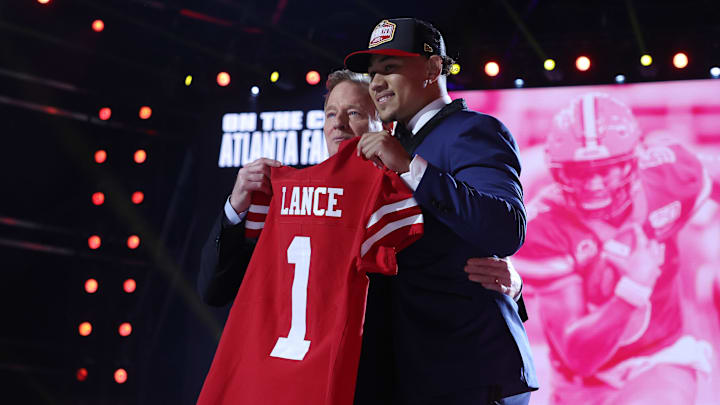The San Francisco 49ers have been simultaneously one of the best- and worst-drafting teams in the NFL, and if that statement seems impossible, you are exactly right.
Over the last eight years, the Niners have drafted, at a minimum, two future Hall of Famers, several Pro Bowlers, high-level starters, and capable depth pieces to the roster.
They also have one of the worst track records for high draft picks of any team over that same timeframe.
Consider San Francisco's 2017 NFL Draft class, which I graded back in 2020. The third-overall pick, defensive end Solomon Thomas, carved out a career as a rotational piece but never came close to the impact player the 49ers expected. Linebacker Reuben Foster, picked 31st overall, was cut in 2018 following injuries and off-field transgressions. The Niners did not grab an impact player until tight end George Kittle in the fifth round.
Kittle being a future Hall of Famer cools the sting from 2017, but overall, the early rounds were not fruitful at all.
That trend has continued for most drafts under general manager John Lynch and head coach Kyle Shanahan. Their early picks often struggle, and if the 49ers are lucky, they salvage their draft in the later rounds.
With the 2025 draft being critical to the Niners' retool, a simple question occurs: Why is this happening?
There is one explanation that could explain everything about the NFL Draft and why San Francisco's classes look the way they do: luck. The draft is not a science, and no team has a complete handle on it. Teams get evaluations wrong all the time. Kittle ending up a future Hall of Famer, quarterback Brock Purdy as Mr. Irrelevant, and of course, who can forget the G.O.A.T., Tom Brady, was a sixth-round pick?
But this is both unsatisfying and not helpful for the 49ers' future draft.
Luckily, there might be another explanation.
49ers draft for 'ceiling' in the early rounds
What is a prospect's ceiling and floor? Consider it the "best" and "worst" case scenarios for a player. Their floor is the "worst" a player likely will be if they are unable to substantially improve upon their pre-existing skills and technique. Their ceiling is the "best" a player likely will be if they do make those improvements. These are predicted ranges, obviously not hard and fast rules.
Players who are high-ceiling have a lot of upside; if everything goes right and/or they improve on the things they need to, the prospect can be an impact player. The flipside, a low-ceiling player is someone who likely will not improve any more in the NFL because they have already maxed out their talents, both physical and mental. The same logic applies to the floor: A high-floor player is likely to be serviceable no matter what because of their pre-existing talent, while a low-floor player could end up out of the league if they do not improve.
Why do these terms matter? Because the Niners have seemed to exclusively draft for ceiling in early rounds, resulting in several high-ceiling, low-floor players who have not developed enough to maximize their potential.
Take San Francisco's first-round picks over the last eight years:
- DE Solomon Thomas (2017)
- LB Reuben Foster (2017)
- OT Mike McGlinchey (2018)
- DE Nick Bosa (2019)
- DT Javon Kinlaw (2020)
- WR Brandon Aiyuk (2020)
- QB Trey Lance (2021)
- WR Rickey Pearsall (2024)
With the exception of McGlinchey (and perhaps Pearsall), I would characterize this group as high-ceiling.
Kinlaw and Lance stand out above the rest; both players were the byproduct of influential trades, and both players were deemed to be incredibly toolsy when drafted. However, they also represent the low-floor pool as well. Kinlaw's physical gifts needed to be translated to technique. Lance came in as a raw player, and his early performances did nothing to quell that notion.
Now, further along in their career, neither player is a 49er.
The 49ers have definitely found successes in the first round. Bosa is everything they could have asked for with a second-overall pick, while Aiyuk took a tumultuous first two years in the NFL before ascending to stardom. These are high-level players, the type every team wants to get in the first round (h/t PFF via Niners Wire).
But San Francisco's success rate overall has been far too low.
What can the 49ers learn?
The 49ers have a tendency to go "star hunting," as I would call it, in the earlier rounds. They take players whose potential could make them superstars. With the exception of a couple players, this seems to outweigh questions of their current ability.
This is not unreasonable; teams want needle-movers earlier in the draft. But it has come at a cost for a team that, until this year, dangled on the precipice of winning a Super Bowl.
Now with the 11th overall pick and a roster in flux, the Niners will need to find a player who can make an impact now and in the future.
Balancing those objectives will be vital for San Francisco.
